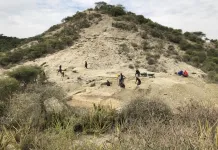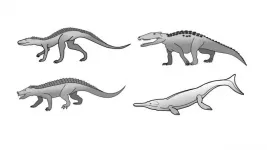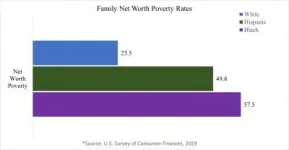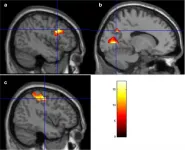Oldest hominins of Olduvai Gorge persisted across changing environments
~2.0 to 1.8 million year-old archaeological site demonstrates that early humans had the skills and tools to cope with ecological change
2021-01-07
(Press-News.org) Olduvai (now Oldupai) Gorge, known as the Cradle of Humankind, is a UNESCO World Heritage site in Tanzania, made famous by Louis and Mary Leakey. New interdisciplinary field work has led to the discovery of the oldest archaeological site in Oldupai Gorge as reported in Nature Communications, which shows that early human used a wide diversity of habitats amidst environmental changes across a 200,000 year-long period.
Located in the heart of eastern Africa, the Rift System is a prime region for human origins research, boasting extraordinary records of extinct human species and environmental records spanning several million years. For more than a century, archaeologists and human palaeontologists have been exploring the East African Rift outcrops and unearthing hominin fossils in surveys and excavations. However, understanding of the environmental contexts in which these hominins lived has remained elusive due to a dearth of ecological studies in direct association with the cultural remains.
In the new study, published in Nature Communications, researchers from the Max Planck Institute for for the Science of Human History teamed up with lead partners from the University of Calgary, Canada, and the University of Dar es Salaam, Tanzania, to excavate the site of 'Ewass Oldupa' (meaning on 'the way to the Gorge' in the local Maa language, as the site straddles the path that links the canyon's rim with its bottom). The excavations uncovered the oldest Oldowan stone tools ever found at Oldupai Gorge, dating to ~2 million years ago. Excavations in long sequences of stratified sediments and dated volcanic horizons indicated hominin presence at Ewass Oldupai from 2.0 to 1.8 million years ago.
Fossils of mammals (wild cattle and pigs, hippos, panthers, lions, hyena, primates), reptiles and birds, together with a range of multidisciplinary scientific studies, revealed habitat changes over 200,000 years in riverine and lake systems, including fern meadows, woodland mosaics, naturally burned landscapes, lakeside palm groves and dry steppe habitats. The uncovered evidence shows periodic but recurrent land use across a subset of environments, punctuated with times when there is an absence of hominin activity.
Dr. Pastory Bushozi of Dar es Salaam University, Tanzania, notes, "the occupation of varied and unstable environments, including after volcanic activity, is one of the earliest examples of adaptation to major ecological transformations."
Hominin occupation of fluctuating and disturbed environments is unique for this early time period and shows complex behavioural adaptations among early human groups. In the face of changing habitats, early humans did not substantially alter their toolkits, but instead their technology remained stable over time. Indicative of their versatility, typical Oldowan stone tools, consisting of pebble and cobble cores and sharp-edged flakes and polyhedral cobbles, continued to be used even as habitats changed. The implication is that by two million years ago, early humans had the behavioural capacity to continually and consistently exploit a multitude of habitats, using reliable stone toolkits, to likely process plants and butcher animals over the long term.
Though no hominin fossils have yet been recovered from Ewass Oldupa, hominin fossils of Homo habilis were found just 350 metres away, in deposits dating to 1.82 million years ago. While it is difficult to know if Homo habilis was present at Ewass Oldupa, Professor Julio Mercader of the University of Calgary asserts that "these early humans were surely ranging widely over the landscape and along shores of the ancient lake." Mercader further notes that this does not discount the possibility that other hominin species, such as the australopithecines, were also using and making stone tools at Ewass Oldupa, as we know that the genus Paranthropus was present in Oldupai Gorge at this time.
INFORMATION:
The findings uncovered at Oldupai Gorge and across eastern Africa indicate that early human movements across and out of Africa were possible by 2 million years ago, as hominins possessed the behavioural ability to expand into novel ecosystems. Professor Michael Petraglia of the Max Planck Institute notes, "This behavioural flexibility arose in the context of the dawn of the evolution of our own genus, Homo, and it set the stage for the eventual global, invasive spread of Homo sapiens."
Partnerships:
Researchers involved in this study include scholars from the Universities of Calgary, Manitoba, McMaster, and Toronto (Canada), the University of Dar es Salaam and Iringa as well as the Ministry of Natural Resources and Tourism (Tanzania), the Max Planck Institute for the Science of Human History (Germany), the Institut Català de Paleoecologia Humana i Evolució Social, and the Madrid Institute for Advanced Study (Spain). All institutions work closely with the Tanzania Commission for Science and Technology, the Division of Antiquities (MNRT), and under the sponsorship of the Canadian Social Sciences and Humanities Research Council (Partnership program).
[Attachments] See images for this press release:

ELSE PRESS RELEASES FROM THIS DATE:
2021-01-07
New research by scientists at the University of Bristol explains how a 'stop-start' pattern of evolution, governed by environmental change, could explain why crocodiles have changed so little since the age of the dinosaurs.
Crocodiles today look very similar to ones from the Jurassic period some 200 million years ago. There are also very few species alive today - just 25. Other animals such as lizards and birds have achieved a diversity of many thousands of species in the same amount of time or less.
Prehistory also saw types of crocodile we don't see today, including giants as big as dinosaurs, plant-eaters, fast ...
2021-01-07
Scientists at the University of Birmingham, UK, have shown that a novel low molecular weight dextran-sulphate, ILB® could play a key role in treating open angle glaucoma (OAG), a neurodegenerative disease that affects over 70 million people worldwide and causes irreversible blindness.
OAG develops slowly over many years. Excessive matrix deposition (fibrosis) within the eye's main fluid drainage site can lead to increased intraocular pressure (IOP), resulting in damage to the optic nerve.1
The research, reported in npj Regenerative Medicine, has ...
2021-01-07
The North Sea is a heavily trafficked area, with major shipping routes crossing its waters, and fisheries, offshore oil rigs, and wind farms populating its waves. All this activity inevitably has an effect on marine wildlife, and scientists are particularly interested in how the harbor porpoise population has fared in the face of such disturbances.
The harbor porpoise is known as a "sentinel species" - animals which indicate the health of an ecosystem and point to potential risks (think of the canary in the coal mine). According to a recent study published in Frontiers ...
2021-01-07
A new study in the Oxford Economic Papers finds that migration flows the last 500 years from high sunlight regions to low sunlight regions influence contemporary health outcomes in destination countries.
The researchers here noted that people's ability to synthesize vitamin D from sunlight declines with skin pigmentation, and that vitamin D deficiency is directly associated with higher risk of mortality, from illnesses including cardiovascular disease, type 1 and type 2 diabetes, hypertension, and certain cancers. Recent research even .finds that vitamin D affects the severity of COVID-19.
Researchers here focused on ...
2021-01-07
Sophia Antipolis, 7 January 2021: Patients with acute heart failure nearly double their risk of dying if they get COVID-19, according to research published today in ESC Heart Failure, a journal of the European Society of Cardiology (ESC).1 The small, single centre study highlights the need for patients with heart failure to take extra precautions to avoid catching COVID-19.
"Our results support prioritising heart failure patients for COVID-19 vaccination once it is available," said study lead investigator Dr. Amardeep Dastidar, a consultant interventional cardiologist at North Bristol NHS Trust and Bristol Heart Institute, UK. "In the meantime, heart failure patients of all ages should ...
2021-01-07
Modelling study suggests that pregnant women in India, Pakistan, Bangladesh, who are exposed to poor air quality, may be at higher risk of stillbirths and miscarriages.
An estimated 349,681 pregnancy losses per year in south Asia were associated with exposure to PM2.5 concentrations that exceeded India's air quality standard (more than 40 μg/m³), accounting for 7% of annual pregnancy loss in the region from 2000-2016.
First study to estimate the effect of air pollution on pregnancy loss across the region indicates that air pollution could be a major contributor to pregnancy loss in south Asia, so controlling air pollution is vital for improving maternal ...
2021-01-07
WHO H. Gilbert Welch MD, MPH, Senior Investigator, Center for Surgery and Public Health, Brigham and Women's Hospital; co-author of a new Sounding Board article published in The New England Journal of Medicine.
WHAT Melanoma of the skin is now the third most commonly diagnosed cancer in the U.S. Diagnoses of melanoma are six times as high today as they were 40 years ago. While incidence of melanoma has been rising steeply, melanoma mortality has been generally stable. In a Sounding Board article, Welch and colleagues present evidence for why they believe that increased diagnostic scrutiny is the primary driver of the rapid rise in melanoma diagnoses.
"Melanoma is now the posterchild for overdiagnosis," said Welch. "Although the conventional response has been ...
2021-01-06
DURHAM, N.C. -- Before the pandemic, one-third of U.S. households with children were already "net worth poor," lacking enough financial resources to sustain their families for three months at a poverty level, finds new research from Duke University.
In 2019, 57 percent of Black families and 50 percent of Latino families with children were poor in terms of net worth. By comparison, the rate for white families was 24 percent.
"These 'net worth poor' households have no assets to withstand a sudden economic loss, like we have seen with COVID-19," said Christina Gibson-Davis, co-author of the study and professor of public policy and sociology at Duke University's Center for Child and Family Policy. "Their savings are virtually nil, ...
2021-01-06
The exponential growth of data traffic in our digital age poses some real challenges on processing power. And with the advent of machine learning and AI in, for example, self-driving vehicles and speech recognition, the upward trend is set to continue. All this places a heavy burden on the ability of current computer processors to keep up with demand.
Now, an international team of scientists has turned to light to tackle the problem. The researchers developed a new approach and architecture that combines processing and data storage onto a single chip by using light-based, or "photonic" processors, which ...
2021-01-06
A study led by University of Ottawa researchers provides empirical evidence that mindfulness has a significant impact on the brain of women suffering from neuropathic pain related to breast cancer treatment. The researchers showed that mindfulness-based stress reduction (MBSR) helps modulate neuropathic pain.
Their findings could make a difference in the lives of many women. In Canada, over a quarter of a million women are expected to be diagnosed with breast cancer - the most diagnosed cancer among women worldwide - in 2020. In addition to the psychological impacts of breast cancer, approximately 20 to 50 percent of survivors report experiencing chronic neuropathic pain following treatment.
We talked to senior author Dr. Andra Smith, Full Professor at the uOttawa School of Psychology, ...
LAST 30 PRESS RELEASES:
[Press-News.org] Oldest hominins of Olduvai Gorge persisted across changing environments
~2.0 to 1.8 million year-old archaeological site demonstrates that early humans had the skills and tools to cope with ecological change





